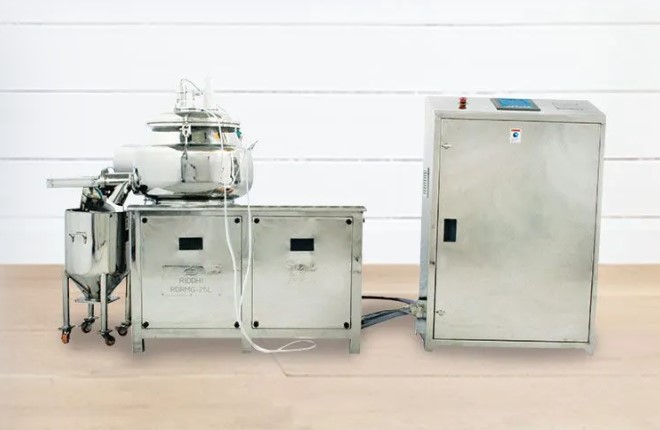
The rapid mixer granulator (RMG) is a versatile piece of equipment used in various industries for mixing and forming granules. This blog post will serve as your comprehensive guide to understanding RMGs, their applications, and their advantages.
What is a Rapid Mixer Granulator?
An RMG is a high-speed mixing machine that utilizes agitation and shear forces to achieve homogeneous mixing of diverse substances. It can handle dry powders, liquids, effervescent materials, and pellets, making it a valuable tool across various manufacturing processes.
Key Functions:
Dry and Wet Mixing: Rapid mixer granulators excel at both dry and wet mixing. They effectively blend dry ingredients and efficiently create uniform wet granules, a crucial step in pharmaceutical tablet production.
Granulation: The high shear forces generated by the RMG efficiently transform dry powders into uniform, controlled-size granules. These granules possess good intensity and are suitable for further processing, such as tableting or capsule filling.
The Benefits of Using a Rapid Mixer Granulator
RMGs offer several benefits over traditional granulation methods, making them popular choices in various industries, particularly pharmaceuticals and chemicals. Here are some key advantages:
Improved Mixing Efficiency:
- High-speed mixing: The RMG’s impeller creates intense turbulence, ensuring rapid and uniform distribution of materials, leading to a homogenous blend with minimal segregation. This consistency is crucial for maintaining consistent product quality.
Enhanced Granulation Process:
- Combined mixing and granulation: Unlike traditional methods requiring separate equipment, rapid mixer granulators perform both mixing and granulation in a single unit. This streamlines the process, saving time and resources.
- Controlled granule size: The chopper assembly breaks down wet mass into uniform granules of the desired size. Precise size control is essential for downstream processes like tableting or encapsulation.
Other Advantages:
- Faster processing: RMGs achieve granulation in shorter processing times compared to traditional methods, leading to increased production capacity.
- Reduced dust exposure: The enclosed design and controlled mixing minimize dust generation, improving worker safety and air quality.
- Improved product quality: Consistent mixing and controlled granulation lead to uniform and high-quality final products.
- Versatility: RMGs can handle a wide range of materials and can be used for both dry and wet mixing applications.
Overall, rapid mixer granulators offer a faster, more efficient, and cost-effective solution for granulation processes compared to traditional methods. Their ability to produce consistent and high-quality products makes them valuable tools across various industries.
Understanding the Working Principle of a Rapid Mixer Granulator
Its primary function involves:
- Mixing powder components: It effectively blends various dry ingredients to ensure a homogeneous mixture.
- Creating granules: It transforms the blended powder into uniform-sized granules.
Here’s a breakdown of the working principle of rapid mixer granulators:
Components:
- Mixing chamber: Typically dome-shaped or conical to minimize material sticking to the walls and ensure complete mixing.
- Impeller: A high-speed rotating blade located at the bottom of the chamber that creates a vortex, promoting efficient mixing.
- Chopper: A high-speed cutting blade that breaks down large lumps and helps form granules of the desired size.
Process:
- Dry mixing: The dry ingredients are loaded into the chamber. The impeller rotates at a moderate speed, causing the powders to rise, whirl, and tumble, achieving a uniform blend.
- Wetting and granulation: A liquid binder is sprayed into the mixing chamber while the impeller continues to rotate. The chopper simultaneously operates at high speed, breaking down the wet mass and distributing the liquid binder evenly. As the liquid wets the particles, they adhere to each other, forming granules.
- Discharge: Once the desired granule size is achieved, the finished product is discharged from the chamber.
Choosing the Right Rapid Mixer Granulator for Your Needs
Here are some key factors to consider when choosing an RMG:
Production Capacity:
- Batch size: Determine the typical size of your batches and choose an RMG with a capacity that meets or slightly exceeds your current needs. This allows for future growth and scalability.
- Production rate: Consider the desired output rate per unit of time and select an RMG that can keep up with your production demands.
Material Properties:
- Physical characteristics: The size, shape, density, and flowability of your raw materials will influence the type of rapid mixer granulator required. For example, fine powders may require a different mixing mechanism than coarse materials.
- Chemical compatibility: Ensure the RMG’s materials of construction are compatible with the chemicals you will be using to avoid corrosion or contamination.
Granule Characteristics:
- Desired size and distribution: The RMG should be able to produce granules of the required size and with a narrow size distribution for consistent product quality.
- Density and porosity: The density and porosity of the granules can impact their flowability and downstream processing. Choose an RMG that offers the necessary control over these properties.
Consulting with a reputable rapid mixer granulator manufacturer or supplier is essential to discuss your specific needs and identify the most suitable equipment for your application. They can provide expert advice on factors like:
- Impeller design and speed: Different impeller designs and speeds can affect the mixing and granulation process.
- Granulation liquid addition method: The method of adding the granulation liquid can impact granule formation and uniformity.
- Discharge system: The discharge system should efficiently remove the finished granules from the RMG.
By carefully considering these factors and consulting with an expert, you can select an RMG that meets your specific needs and ensures efficient, high-quality production.
Conclusion:
Rapid mixer granulators are powerful tools that offer efficient and reliable solutions for mixing and granulating various materials across numerous industries. Their speed, precision, and scalability make them valuable assets for any manufacturing process requiring the creation of uniform and high-quality granules.




